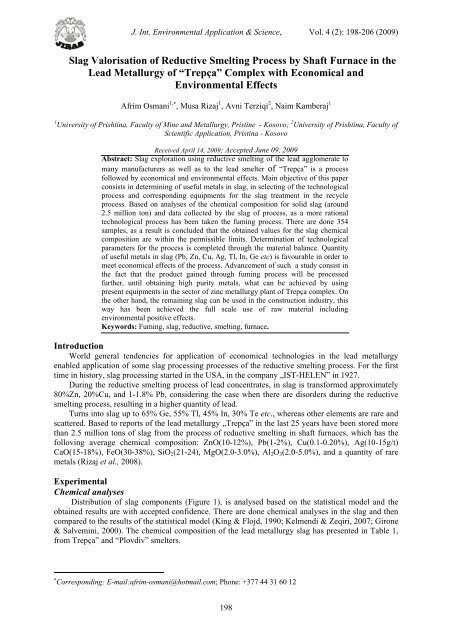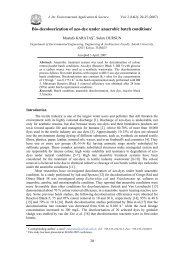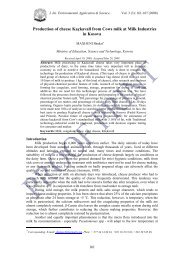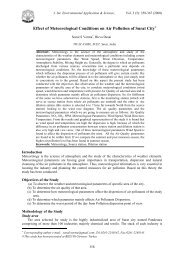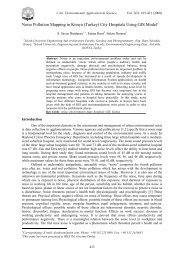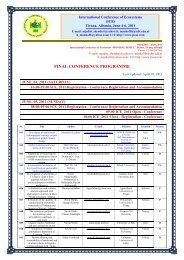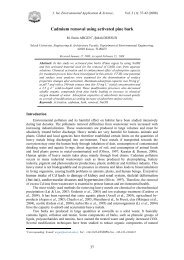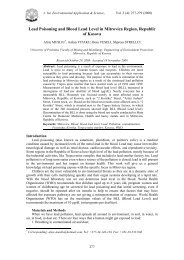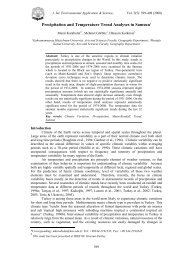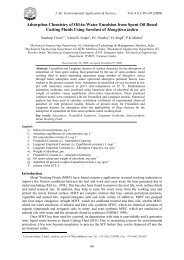Slag Valorisation of Reductive Smelting Process by Shaft Furnace in ...
Slag Valorisation of Reductive Smelting Process by Shaft Furnace in ...
Slag Valorisation of Reductive Smelting Process by Shaft Furnace in ...
Create successful ePaper yourself
Turn your PDF publications into a flip-book with our unique Google optimized e-Paper software.
J. Int. Environmental Application & Science, Vol. 4 (2): 198-206 (2009)<br />
<strong>Slag</strong> <strong>Valorisation</strong> <strong>of</strong> <strong>Reductive</strong> <strong>Smelt<strong>in</strong>g</strong> <strong>Process</strong> <strong>by</strong> <strong>Shaft</strong> <strong>Furnace</strong> <strong>in</strong> the<br />
Lead Metallurgy <strong>of</strong> “Trepça” Complex with Economical and<br />
Environmental Effects<br />
Afrim Osmani 1,∗ , Musa Rizaj 1 , Avni Terziqi 2 , Naim Kamberaj 1<br />
1 University <strong>of</strong> Prisht<strong>in</strong>a, Faculty <strong>of</strong> M<strong>in</strong>e and Metallurgy, Prist<strong>in</strong>e - Kosovo; 2 University <strong>of</strong> Prisht<strong>in</strong>a, Faculty <strong>of</strong><br />
Scientific Application, Prist<strong>in</strong>a - Kosovo<br />
Received April 14, 2009; Accepted June 09, 2009<br />
Abstract: <strong>Slag</strong> exploration us<strong>in</strong>g reductive smelt<strong>in</strong>g <strong>of</strong> the lead agglomerate to<br />
many manufacturers as well as to the lead smelter <strong>of</strong> “Trepça” is a process<br />
followed <strong>by</strong> economical and environmental effects. Ma<strong>in</strong> objective <strong>of</strong> this paper<br />
consists <strong>in</strong> determ<strong>in</strong><strong>in</strong>g <strong>of</strong> useful metals <strong>in</strong> slag, <strong>in</strong> select<strong>in</strong>g <strong>of</strong> the technological<br />
process and correspond<strong>in</strong>g equipments for the slag treatment <strong>in</strong> the recycle<br />
process. Based on analyses <strong>of</strong> the chemical composition for solid slag (around<br />
2.5 million ton) and data collected <strong>by</strong> the slag <strong>of</strong> process, as a more rational<br />
technological process has been taken the fum<strong>in</strong>g process. There are done 354<br />
samples, as a result is concluded that the obta<strong>in</strong>ed values for the slag chemical<br />
composition are with<strong>in</strong> the permissible limits. Determ<strong>in</strong>ation <strong>of</strong> technological<br />
parameters for the process is completed through the material balance. Quantity<br />
<strong>of</strong> useful metals <strong>in</strong> slag (Pb, Zn, Cu, Ag, Tl, In, Ge etc) is favourable <strong>in</strong> order to<br />
meet economical effects <strong>of</strong> the process. Advancement <strong>of</strong> such a study consist <strong>in</strong><br />
the fact that the product ga<strong>in</strong>ed through fum<strong>in</strong>g process will be processed<br />
further, until obta<strong>in</strong><strong>in</strong>g high purity metals, what can be achieved <strong>by</strong> us<strong>in</strong>g<br />
present equipments <strong>in</strong> the sector <strong>of</strong> z<strong>in</strong>c metallurgy plant <strong>of</strong> Trepça complex. On<br />
the other hand, the rema<strong>in</strong><strong>in</strong>g slag can be used <strong>in</strong> the construction <strong>in</strong>dustry, this<br />
way has been achieved the full scale use <strong>of</strong> raw material <strong>in</strong>clud<strong>in</strong>g<br />
environmental positive effects.<br />
Keywords: Fum<strong>in</strong>g, slag, reductive, smelt<strong>in</strong>g, furnace.<br />
Introduction<br />
World general tendencies for application <strong>of</strong> economical technologies <strong>in</strong> the lead metallurgy<br />
enabled application <strong>of</strong> some slag process<strong>in</strong>g processes <strong>of</strong> the reductive smelt<strong>in</strong>g process. For the first<br />
time <strong>in</strong> history, slag process<strong>in</strong>g started <strong>in</strong> the USA, <strong>in</strong> the company „IST-HELEN” <strong>in</strong> 1927.<br />
Dur<strong>in</strong>g the reductive smelt<strong>in</strong>g process <strong>of</strong> lead concentrates, <strong>in</strong> slag is transformed approximately<br />
80%Zn, 20%Cu, and 1-1.8% Pb, consider<strong>in</strong>g the case when there are disorders dur<strong>in</strong>g the reductive<br />
smelt<strong>in</strong>g process, result<strong>in</strong>g <strong>in</strong> a higher quantity <strong>of</strong> lead.<br />
Turns <strong>in</strong>to slag up to 65% Ge, 55% Tl, 45% In, 30% Te etc., whereas other elements are rare and<br />
scattered. Based to reports <strong>of</strong> the lead metallurgy „Trepça” <strong>in</strong> the last 25 years have been stored more<br />
than 2.5 million tons <strong>of</strong> slag from the process <strong>of</strong> reductive smelt<strong>in</strong>g <strong>in</strong> shaft furnaces, which has the<br />
follov<strong>in</strong>g average chemical composition: ZnO(10-12%), Pb(1-2%), Cu(0.1-0.20%), Ag(10-15g/t)<br />
CaO(15-18%), FeO(30-38%), SiO 2 (21-24), MgO(2.0-3.0%), Al 2 O 3 (2.0-5.0%), and a quantity <strong>of</strong> rare<br />
metals (Rizaj et al., 2008).<br />
Experimental<br />
Chemical analyses<br />
Distribution <strong>of</strong> slag components (Figure 1), is analysed based on the statistical model and the<br />
obta<strong>in</strong>ed results are with accepted confidence. There are done chemical analyses <strong>in</strong> the slag and then<br />
compared to the results <strong>of</strong> the statistical model (K<strong>in</strong>g & Flojd, 1990; Kelmendi & Zeqiri, 2007; Girone<br />
& Salvem<strong>in</strong>i, 2000). The chemical composition <strong>of</strong> the lead metallurgy slag has presented <strong>in</strong> Table 1,<br />
from Trepça” and “Plovdiv” smelters.<br />
∗ Correspond<strong>in</strong>g: E-mail:afrim-osmani@hotmail.com; Phone: +377 44 31 60 12<br />
198
J. Int. Environmental Application & Science, Vol. 4 (2): 198-206 (2009)<br />
500<br />
400<br />
f(x)<br />
300<br />
200<br />
100<br />
0<br />
0 5 10 15 20 25 30 35 40 45 50<br />
x %<br />
Pb<br />
FeO<br />
ZnO<br />
CaO SiO 2 S<br />
Figure1. Distributions <strong>of</strong> slag components (Pb; ZnO; FeO; CaO; SiO 2 and S)<br />
Table 1. Chemical composition <strong>of</strong> slag <strong>in</strong> lead metallurgy “Trepça”<br />
Pb % ZnO % FeO % CaO % SiO 2 % S % Cu % MgO % Al 2 O 3<br />
2.75 11.20 37.05 13.60 21.30 - 0.12 2.57 7.34<br />
2.22 10.70 36.42 16.78 20.60 - 0.13 3.30 7.34<br />
1.5-2 7-12 32-34 20-22 18-20 1.5 - 3.30 7.34<br />
2.24 7.09 37.42 15.93 24.50 1.20 0.14 3.04 8.28<br />
0.5-1.5 10-14 30-35 18-21 21-24 - - 3.55 7.95<br />
2.05 10.15 36.30 16.40 20.70 - 0.17 3.04 8.28<br />
1.41 9.00 28.72 18.42 23.17 1.38 0.14 2.70 9.48<br />
0.87 9.39 37.14 17.46 25.10 1.65 0.13 3.08 8.10<br />
2.06 9.45 32.76 18.62 24.43 1.87 0.24 3.95 8.80<br />
1.90 12.23 34.46 9.37 19.14 0.91 0.16 - -<br />
1.91 8.10 35.75 15.87 30.70 1.93 0.10 2.82 6.38<br />
1.73 5.81 37.12 14.85 24.33 1.90 0.21 3.30 6.22<br />
Table 2. Chemical composition <strong>of</strong> slag <strong>in</strong> lead metallurgy “Plovdiv”<br />
Components Sample-1, % Sample- 2, %<br />
FeO 38.00 38.00<br />
CaO 12.00 13.00<br />
SiO 2 24.00 19.00<br />
ZnO 16.00 12.00<br />
Pb 1.00 2.10<br />
Cu - 0.30<br />
MgO 2.00 2.20<br />
Al 2 O 3 3.00 3.80<br />
S - 2.00<br />
Table.3. Chemical composition <strong>of</strong> slag <strong>in</strong> lead metallurgy„Plovdiv” after fum<strong>in</strong>g process<br />
Components Sample-1, % Sample- 2, %<br />
FeO 40.35 41.05<br />
CaO 12.00 12.00<br />
SiO 2 25.03 20.26<br />
Zn 2.10 2.23<br />
Pb 0.10 0.10<br />
Cu - 0.23<br />
MgO 2.38 2.30<br />
Al 2 O 3 4.27 5.15<br />
S - 0.90<br />
199
J. Int. Environmental Application & Science, Vol. 4 (2): 198-206 (2009)<br />
<strong>Slag</strong> treatment accord<strong>in</strong>g to fum<strong>in</strong>g process<br />
Basic processes <strong>of</strong> the lead-z<strong>in</strong>c slag process<strong>in</strong>g are as follows: fum<strong>in</strong>g, vells, elektrothermic and<br />
sajrosmelt process. Consider<strong>in</strong>g our case, the most acceptable process is chosen the fum<strong>in</strong>g process.<br />
Fum<strong>in</strong>g process accomplished through the blow<strong>in</strong>g <strong>of</strong> the smelted slag with mix<strong>in</strong>g air and<br />
reduc<strong>in</strong>g agents under pressure. In the reductive space available under such conditions <strong>in</strong> temperature<br />
1200-1300 ° C, metal oxides there will be reduced and stems <strong>of</strong> these metals will turn <strong>in</strong>to a gaseous<br />
state.<br />
The process basic reactions are:<br />
C + O 2 = CO 2<br />
CO 2 + C = 2CO<br />
ZnO + C = Zn + CO<br />
ZnO + CO = Zn + CO 2<br />
PbO + CO = Pb + CO 2<br />
The equilibration constant <strong>of</strong> this reaksion is as follows:<br />
K = P A · [PbO] zgj / P B<br />
P A / P B = K / [PbO] zgj<br />
P A , P B , and (PbO) sl - are the partial pressure <strong>of</strong> CO, CO 2 and PbO (Gjokiç, 1982) Metalurgija<br />
sirovog olova u topionici „Trepçe” (Zveçan, 1982). From the above mentioned reaction can be<br />
concluded that <strong>in</strong> order to reduce PbO or another oxide from the slag the higher concentration <strong>of</strong> CO is<br />
needed <strong>in</strong> the gases <strong>of</strong> the process how the lower is oxide concentration <strong>in</strong> the slag. Dur<strong>in</strong>g the<br />
reduction process will be formed steams <strong>of</strong> z<strong>in</strong>c and lead which on the liquid bath space and <strong>in</strong> the<br />
gas-pipel<strong>in</strong>e, steams <strong>of</strong> such metals are oxidised with the air oxygen towards the correspond<strong>in</strong>g oxides.<br />
2Zn + O 2 = 2ZnO<br />
2Pb + O 2 = 2PbO<br />
Z<strong>in</strong>c oxide formed dur<strong>in</strong>g the oxidisation as powder is taken out along with the gases <strong>of</strong> the<br />
process. The fum<strong>in</strong>g process <strong>of</strong> the slag takes 2 to 3 hour duration. More <strong>of</strong> Pb and Cd is extracted <strong>in</strong> a<br />
few m<strong>in</strong>utes. Copper and precious metals dur<strong>in</strong>g the fum<strong>in</strong>g process are mixed with the slag, this way<br />
they are considered as a disadvantage <strong>of</strong> the fum<strong>in</strong>g process (Loskutov, 1991). In such cases when the<br />
concentration <strong>of</strong> z<strong>in</strong>c <strong>in</strong> the slag is up to 8%, its activity coefficient <strong>in</strong> smelt<strong>in</strong>g is approximately one.<br />
Dur<strong>in</strong>g evaporation process <strong>of</strong> z<strong>in</strong>c, blow<strong>in</strong>g pressure have an important role. Dependence <strong>of</strong> lead<br />
steams’ pressure and its components from temperature nearly can be given through the follow<strong>in</strong>g<br />
expression.<br />
lg p Pb ( l )<br />
= 6210 / T + 6,34 ;<br />
lg p = -7640 / T + 8,04 ;<br />
PbO ( l )<br />
lg p = -7850 / T + 9,19<br />
PbS (ng)<br />
Dur<strong>in</strong>g the fum<strong>in</strong>g process, flow <strong>of</strong> z<strong>in</strong>c evaporation varies with<strong>in</strong> a wide range (15-50kg/m<strong>in</strong>)<br />
depend<strong>in</strong>g mostly from the slag composition. Specific productivity <strong>of</strong> the fum<strong>in</strong>g shaft furnace is 45 to<br />
55 t/m 2 <strong>of</strong> slag (Abdejev et al., 1985).<br />
In Trepça smelter, large lead production is made <strong>in</strong> shaft furnace. Two <strong>of</strong> them had capacity <strong>of</strong><br />
260t/24h (for each). Whereas, the other one after reconstruction have capacity <strong>of</strong> 360 t/day.<br />
<strong>Slag</strong> production varied from time to time and its production ranged form 55.000- 60.000t/year.<br />
For slag process<strong>in</strong>g <strong>in</strong>tend<strong>in</strong>g to exploit useful components both the fresh one and recycl<strong>in</strong>g from the<br />
store, <strong>in</strong> cont<strong>in</strong>uity with optimal parameters obta<strong>in</strong>ed from the program is determ<strong>in</strong>ed the unit capacity<br />
<strong>of</strong> the fum<strong>in</strong>g furnace. Production <strong>of</strong> a fum<strong>in</strong>g furnace is 60 tpd and a ratio between the fresh slag and<br />
old one is 3 :1 (weigh ratio).<br />
Fum<strong>in</strong>g furnace capacity is calculated based on the follow<strong>in</strong>g parameters: 30 days <strong>of</strong> annual<br />
repair, number <strong>of</strong> work<strong>in</strong>g days 335, operation utility factor is 0.87. For the capacity <strong>of</strong> a furnace 60<br />
tpd is taken the optimal value <strong>of</strong> technological parameters, such as: oxygen percentage <strong>in</strong> the air flow<br />
and the quantity <strong>of</strong> slag processed.<br />
200
J. Int. Environmental Application & Science, Vol. 4 (2): 198-206 (2009)<br />
Material balance<br />
Material balance is determ<strong>in</strong>ed based on <strong>in</strong>put and output quantities <strong>of</strong> fum<strong>in</strong>g furnace, what<br />
proves the mass conservation law. Calculation is done based on the companies (KCM- Plovdiv)<br />
balance which have similar with chemical composition <strong>of</strong> slag to that <strong>of</strong> Trepça complex, based on<br />
<strong>in</strong>terpolation is obta<strong>in</strong>ed a certa<strong>in</strong> number <strong>of</strong> the given values. Us<strong>in</strong>g approximate methods are<br />
obta<strong>in</strong>ed mathematical equations.<br />
Material balance for fum<strong>in</strong>g process is given <strong>in</strong> the follow<strong>in</strong>g tables, for the slag <strong>in</strong> the lead<br />
metallurgy <strong>of</strong> „Trepça” and <strong>in</strong>put parameters given such as: air blown temperature 540 °C ; air<br />
enriched <strong>by</strong> oxygen O 2 = 23% ; carbon percentage <strong>in</strong> coal C= 70% and slag quantity for a cycle <strong>of</strong> 70t.<br />
In the follow<strong>in</strong>g tables are given the ma<strong>in</strong> parameters <strong>of</strong> the fum<strong>in</strong>g process.<br />
Table 4. Input selected values<br />
Oxygen percentage, % 23.000<br />
Air temperature, °C 600.000<br />
Coal quantity, t 60.000<br />
carbon percentage, % 70.000<br />
z<strong>in</strong>c percentage, % 9.131<br />
lead percentage, % 1.362<br />
copper percentage, % 0.211<br />
Table 5. Chemical composition <strong>of</strong> sublimation<br />
Components<br />
sublimate<br />
kg %<br />
Zn 7.4254 59.9011<br />
Pb 1.3048 10.5256<br />
Cu 0.0148 0.1192<br />
SiO2 0.2133 1.7206<br />
FeO 0.1059 0.8541<br />
CaO 0.3020 2.4359<br />
MgO 0.0334 0.2693<br />
Al2O3 0.1220 0.9845<br />
S 0.2252 1.0000<br />
Rema<strong>in</strong> 2.6494 21.3729<br />
Table.6. Chemical composition <strong>of</strong> the slag output<br />
after fum<strong>in</strong>g process<br />
Waste slag<br />
Components<br />
kg %<br />
Zn 1.5086 1.6013<br />
Pb 0.0472 0.0501<br />
Cu 0.1962 0.2083<br />
SiO 2 22.8749 24.2801<br />
FeO 34.7360 36.8699<br />
CaO 15.8088 16.7800<br />
MgO 2.9727 3.1553<br />
Al 2 O 3 7.2002 7.6425<br />
S 1.1043 1.1721<br />
Rema<strong>in</strong> 7.7635 8.2404<br />
Table 7. Chemical composition <strong>of</strong> gases<br />
Components<br />
Gases<br />
kg %<br />
Zn 0.1970 0.2393<br />
Pb 0.0100 0.0121<br />
SiO 2 0.0186 0.0225<br />
S 0.1501 0.1823<br />
H 2 0.2531 0.3075<br />
N 2 53.7763 65.3149<br />
CO 13.3439 16.2070<br />
CO 2 6.0228 7.3150<br />
H 2 O 4.1660 5.0599<br />
Rema<strong>in</strong> 4.3962 5.3394<br />
201
J. Int. Environmental Application & Science, Vol. 4 (2): 198-206 (2009)<br />
Table 8. Ma<strong>in</strong> parameters for the fum<strong>in</strong>g<br />
The time blown for one cycle m<strong>in</strong> 132.500<br />
<strong>Process</strong> length m<strong>in</strong> 162.500<br />
Number <strong>of</strong> the cycle <strong>in</strong> the day cycle/day 8.862<br />
The surplus coefficient <strong>of</strong> air 0.500<br />
Coal quantity for one cycle kg 10779.000<br />
Coal quantity for one cycle kg/m<strong>in</strong> 81.351<br />
Coal quantity for one day t 95.519<br />
Coal quantity for one year t 31903.187<br />
Temperature <strong>of</strong> output gases C 1282.000<br />
Speed <strong>of</strong> rectified Zn kg/m<strong>in</strong> 3.371<br />
Day’s production <strong>of</strong> the furnace t/day t 531.692<br />
Yearly production <strong>of</strong> the furnace t/(year m 2 ) 35.722<br />
Quantity <strong>of</strong> the processed slag <strong>in</strong> day t 531.692<br />
Quantity <strong>of</strong> processed slag <strong>in</strong> year t 177.585<br />
Sublimation quantity for one cycle kg 7437.643<br />
Sublimation quantity for one day t 65.909<br />
Sublimation quantity for one year t 22013.593<br />
The general quantity <strong>of</strong> the air kg 42586.491<br />
The general quantity <strong>of</strong> the air kg/m<strong>in</strong> 262.071<br />
The general quantity <strong>of</strong> the air m 3 /m<strong>in</strong> 202.716<br />
The general quantity <strong>of</strong> the gases t 49.400<br />
Z<strong>in</strong>c quantity for one cycle kg 4455.232<br />
Z<strong>in</strong>c quantity for one day t 39.480<br />
Z<strong>in</strong>c quantity for one year t 13186.391<br />
Lead quantity for one cycle kg 782.856<br />
Lead quantity for one day t 6.937<br />
Lead quantity for one year t 2317.061<br />
Copper quantity for one cycle kg 8.862<br />
Copper quantity for one day t 78.531<br />
Copper quantity for one year t 26.229<br />
Table. 9. Input quantities <strong>in</strong> the material<br />
Components<br />
<strong>Slag</strong> powder coal Air Sum<br />
kg kg % kg % kg<br />
Zn 9.131 - - - - 9.131<br />
Pb 1.362 - - - - 1.362<br />
Cu 0.211 - - - - 0.211<br />
SiO 2 23.107 - - - - 23.107<br />
FeO 34.842 - - - - 34.842<br />
CaO 16.111 - - - - 16.111<br />
MgO 3.006 - - - - 3.006<br />
Al 2 O 3 7.322 - - - - 7.322<br />
S 1.300 0.180 1.000 - - 1.480<br />
Rema<strong>in</strong> 3.608 1.976 11.000 1.056 1.488 17.736<br />
C - 12.576 70.000 - - 12.576<br />
O 2 - 1.617 9.000 16.325 23.000 17.942<br />
H 2 - 0.898 5.000 - - 0.898<br />
N 2 - 0.180 1.000 53.597 75.512 53.776<br />
CO - - - - - -<br />
CO 2 - - - - - -<br />
H 2 O - 0.539 3.000 - - 0.539<br />
Sum 100.000 17.965 100.000 70.978 100.000 188.943<br />
202
J. Int. Environmental Application & Science, Vol. 4 (2): 198-206 (2009)<br />
Table 10. Output quantities <strong>in</strong> the material balance<br />
Components Sublimation Waste slag Gases Sum<br />
kg % kg % kg % kg<br />
Zn 7.425 59.901 1.509 1.601 0.197 0.239 9.131<br />
Pb 1.305 10.526 0.047 0.050 0.010 0.012 1.362<br />
Cu 0.015 0.119 0.196 0.208 - - 0.211<br />
SiO 2 0.213 1.721 22.875 24.280 0.019 0.023 23.107<br />
FeO 0.106 0.854 34.736 36.870 - - 34.842<br />
CaO 0.302 2.436 15.809 16.780 - - 16.111<br />
MgO 0.033 0.269 2.973 3.155 - - 3.006<br />
Al 2 O 3 0.122 0.985 7.200 7.643 - - 7.322<br />
S 0.225 1.000 1.104 1.172 0.150 0.182 1.480<br />
Rema<strong>in</strong> 2.649 21.373 7.764 8.240 4.396 5.339 14.809<br />
C - - - - - - -<br />
O 2 - - - - - - -<br />
H 2 - - - - 0.253 0.308 0.253<br />
N 2 - - - - 53.776 65.315 53.776<br />
CO - - - - 13.344 16.207 13.344<br />
CO 2 - - - - 6.023 7.315 6.023<br />
H 2 O - - - - 4.166 5.060 4.166<br />
Sum 12.396 100.000 94.213 100.000 82.334 100.000 188.943<br />
S, 1.000 Rema<strong>in</strong>, 21.373<br />
Al2O3, 0.985<br />
MgO, 0.269<br />
CaO, 2.436<br />
FeO, 0.854<br />
Zn, 59.901<br />
SiO2, 1.721<br />
Cu, 0.119<br />
Pb, 10.526<br />
Zn Pb Cu SiO2 FeO CaO MgO Al2O3 S Rema<strong>in</strong><br />
Figure 2. Chemical composition <strong>of</strong> the obta<strong>in</strong>ed product (sublimation)<br />
203
J. Int. Environmental Application & Science, Vol. 4 (2): 198-206 (2009)<br />
Rema<strong>in</strong>, 8.240 Zn, 1.601 Pb, 0.050<br />
Cu, 0.208<br />
S, 1.172<br />
Al2O3, 7.643<br />
MgO, 3.155<br />
SiO2, 24.280<br />
CaO, 16.780 FeO, 36.870<br />
Zn Pb Cu SiO2 FeO CaO<br />
MgO Al2O3 S Rema<strong>in</strong><br />
Figure 3. Chemical composition <strong>of</strong> the slag output <strong>of</strong> fum<strong>in</strong>g process, %<br />
Zn, 0.2393<br />
Pb, 0.012 1<br />
SiO 2 , 0.0225<br />
S, 0.1823<br />
H 2 , 0.3075<br />
Rema<strong>in</strong>, 5.3394<br />
H 2 O, 5.0599<br />
CO 2 , 7.3150<br />
CO, 16.2070<br />
N 2 , 65.3149<br />
Figure 4. Chemical composition <strong>of</strong> the output gases (Zn, Pb, SiO 2 , S, H 2 , N 2 , CO, CO 2 , H 2 O, Rema<strong>in</strong>)<br />
204
J. Int. Environmental Application & Science, Vol. 4 (2): 198-206 (2009)<br />
t/year<br />
<strong>Slag</strong>, 177585<br />
180000<br />
160000<br />
140000<br />
120000<br />
100000<br />
80000<br />
60000<br />
40000<br />
20000<br />
Zn, 13186<br />
Pb, 2317 Cu, 26<br />
Coal, 31903<br />
0<br />
Zn Pb Cu Coal <strong>Slag</strong><br />
Figure 5. Pb, Zn,Cu and slag quantity for one year<br />
Conclusion<br />
In this paper is <strong>in</strong>tended to have knowledge <strong>of</strong> chemical composition and determ<strong>in</strong>ation <strong>of</strong> the<br />
amount <strong>of</strong> slag <strong>in</strong> the slag store (around 2.5 million ton). S<strong>in</strong>ce, it is supposed that there is a qualitative<br />
raw material (Pb, Zn, Cu, Ag etc.) which can be processed with the fum<strong>in</strong>g process, therefore there are<br />
presented comparative data to some manufacturers <strong>of</strong> different countries that use almost the same<br />
technology for smelt<strong>in</strong>g the lead agglomerate. Based on the raw material available, we suggest:<br />
a) The fum<strong>in</strong>g process, as a technological process <strong>of</strong> many advantages for the treatment <strong>of</strong> melted<br />
slag and solid slag from the store.<br />
b) <strong>Slag</strong>, apart from the above mentioned components has an amount <strong>of</strong> rare metals, such as: Ge, In,<br />
Tl, etc. A positive impact <strong>in</strong> the economic parameters <strong>of</strong> the process will be achieved <strong>by</strong> us<strong>in</strong>g<br />
them.<br />
c) <strong>Slag</strong> quantity used for the fum<strong>in</strong>g process is <strong>of</strong> mixed type, the ratio between the fresh slag and<br />
slag from the dam will be 3:1 (or 60 to 70 % fresh and 40 to 30 % from the dam).<br />
d) Therefore, slag quantity ga<strong>in</strong>ed dur<strong>in</strong>g the reductive smelt<strong>in</strong>g process <strong>in</strong> the lead metallurgy <strong>of</strong><br />
„Trepça” (55.000-60.000 tpy) is sufficient for normal development <strong>of</strong> fum<strong>in</strong>g process.<br />
e) Given data show <strong>of</strong> reductive smelt<strong>in</strong>g process <strong>in</strong> “Trepça” has the lowest smelt<strong>in</strong>g level<br />
compared to the slag <strong>in</strong> Plovdiv, so it has a higher level for the advancement <strong>of</strong> fum<strong>in</strong>g process.<br />
f) Through a special program compiled with „Pascal” language is conducted the material balance <strong>of</strong><br />
process, what represents quantitative difference <strong>of</strong> the participat<strong>in</strong>g components’ level dur<strong>in</strong>g the<br />
technological process development.<br />
g) Suggested basic <strong>in</strong>put parameters, which enable us to have the most optimal characteristics <strong>of</strong><br />
the process, are as follovs:<br />
g I - air temperature which is blown is 540 °C ;<br />
g II - pure air with 23% O 2 ;<br />
g III - carbon percentage <strong>in</strong> coal 70 % and<br />
g IV - slag quantity per cycle is 70 t.<br />
References<br />
Abdejev M, Ushakov V, Kolesnikov A, (1985) Velcovanje c<strong>in</strong>k sv<strong>in</strong>cov sadrzhajuqih materialov,<br />
Metalurgija, Moskova.<br />
Giovanni G, Tommaso S, Lezioni D, (2000) Statistica.<br />
Gjokiç V, (1982) Metalurgija sirovog olova u topionici „Trepçe”, Zveçan, 1982.<br />
Hubler J, (1996) Stastistique pour l’e’conomie, Paris.<br />
205
J. Int. Environmental Application & Science, Vol. 4 (2): 198-206 (2009)<br />
Kelmendi Sh., Zeqiri I, (2007) Mathematical methods for eng<strong>in</strong>eer<strong>in</strong>g, University Book, Prisht<strong>in</strong>a.<br />
Loskutov FM, (1991) Metalurgija tjazhelih cvetnih metalov, 2cv<strong>in</strong>ec i c<strong>in</strong>k, metalurgizdat, Moskva.<br />
Rizaj M, Terziqi A, Beqiri E, Kamberaj N, (2008) Concentration and Distribution Characteristics <strong>of</strong><br />
Trepça <strong>Shaft</strong> <strong>Furnace</strong> <strong>Slag</strong>, World <strong>of</strong> Metallurgy-Erzmetall 61N0.2, Clausthal-Zellerfeld,<br />
Germany.<br />
206


